South Korean Domestic Courier, Express, and Parcel Market Size
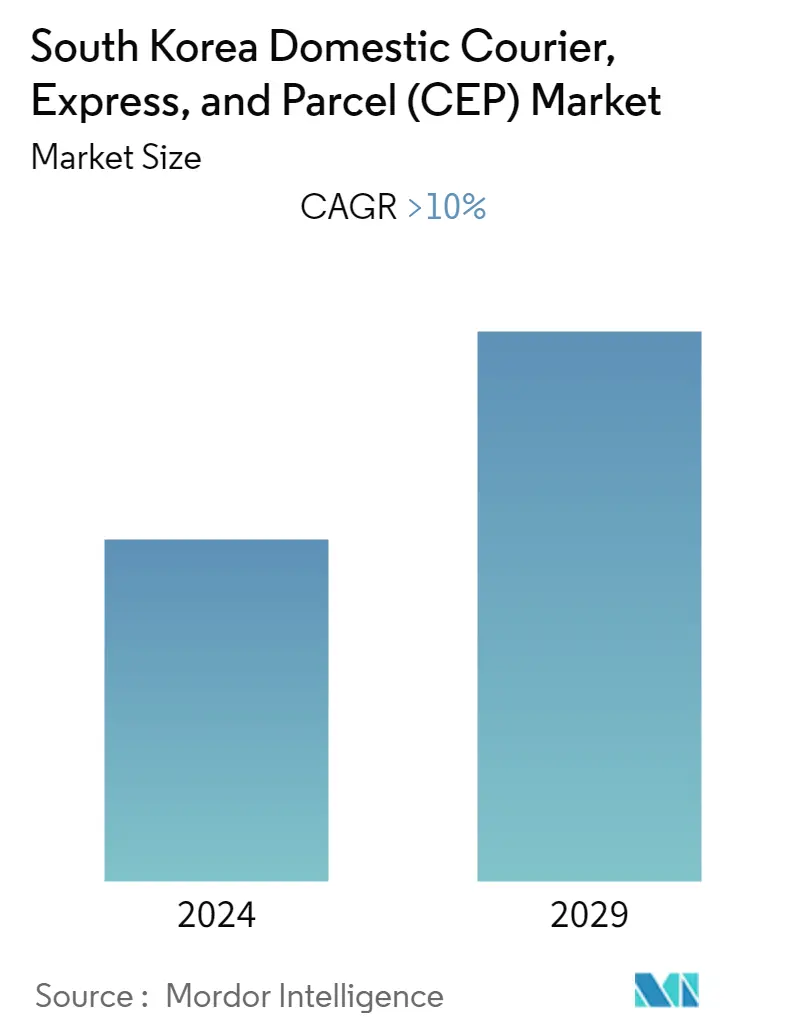
| Study Period | 2020 - 2029 |
| Base Year For Estimation | 2023 |
| Forecast Data Period | 2024 - 2029 |
| Historical Data Period | 2020 - 2022 |
| CAGR | > 10.00 % |
| Market Concentration | Low |
Major Players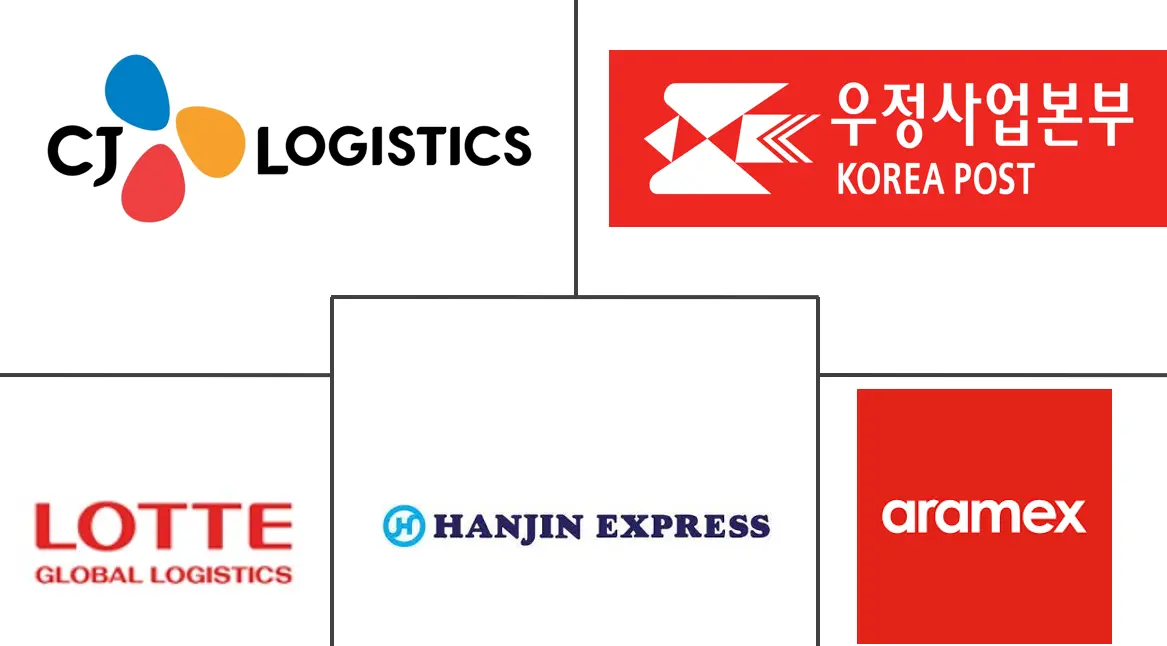
*Disclaimer: Major Players sorted in no particular order |
South Korean Domestic Courier, Express, and Parcel Market Analysis
The South Korean domestic courier, express, and parcel (CEP) market is expected to register a CAGR of over 10% during the forecast period (2023-2028).
- As a result of the COVID-19 pandemic, distribution infrastructure was expanded across the country outside Seoul and metropolitan centers. The retail industry has stepped up to strengthen the same-day delivery system. As non-face-to-face consumption became commonplace due to the COVID-19 pandemic, an immediate delivery system was introduced, and omnichannel started becoming consolidated.
- Even though the Korean e-commerce market was ranked fourth in the world in 2020, its share of the total retail market, including online and offline sales, was 35.8%, placing it first. The number of online market transactions exceeded USD 155 billion in 2021.
- Moreover, In September 2022, online shoppers in South Korea spent more than USD 1.93 billion on food and beverages, USD 1.18 billion on clothing, USD 750 million on cosmetics, and USD 1.1 billion on household goods.
- The leader among online shopping properties active as of September 2021 is Coupang. Their fast next-day delivery service is one of their most prized services. Coupang defeated G-market, an eBay-owned website, after months of increasing market share.
- However, in 2021, the South Korean Trade, Industry, and Energy Ministry planned to invest more than USD 267 million to accelerate the growth of online retail in the country, and this investment was made over the next three years. in addition, Ministry planned to develop unmanned delivery services across the country, as well as more than 4,000 logistics robots will be distributed by 2023. Thus, the growing e-commerce sector and government initiatives will drive the domestic express and parcel delivery industry in the country.
South Korean Domestic Courier, Express, and Parcel Market Trends
This section covers the major market trends shaping the South Korea Domestic CEP Market according to our research experts:
Increasing Online Retail Sales Driving the Market
Retail sales witnessed significant growth in the country, as in October 2022, retail sales experienced a growth rate of more than 7% when compared to the same period in the previous year. This growth was majorly driven by the rising number of people's outdoor activities and demand for various services due to the eased pandemic restrictions. In addition, in October 2022, according to the Ministry of Trade, Industry, and Energy, the combined sales of 25 major offline and online retailers amounted to more than USD 10.9 billion.
Moreover, the sales from offline stores increased by more than 6%, which was driven by growing demand for fashion items, goods for children and sporting, etc. Meanwhile, in October 2022 sales from online platforms advanced with more than 8% growth, reaching KRW 7 trillion (USD 5.73 billion), with the continuous spread of the contactless shopping trend amid the pandemic. Moreover, in October 2022, online platforms contributed more than 48% of the total sales, which was up by 47% compared to the same period in the previous year.
Moreover, in September 2022, according to statistics Korea, retail commodities such as clothing, Computers, and computer-related appliances, cosmetics, Sports and leisure appliances, etc. online sales witnessed significant growth. Moreover, in Q1 2022, the transaction value of online food and beverage sales reached more than KRW 6.93 trillion (USD 5.63 billion). Thus, the growing online retail sales will drive the domestic express and parcel industry in the country.
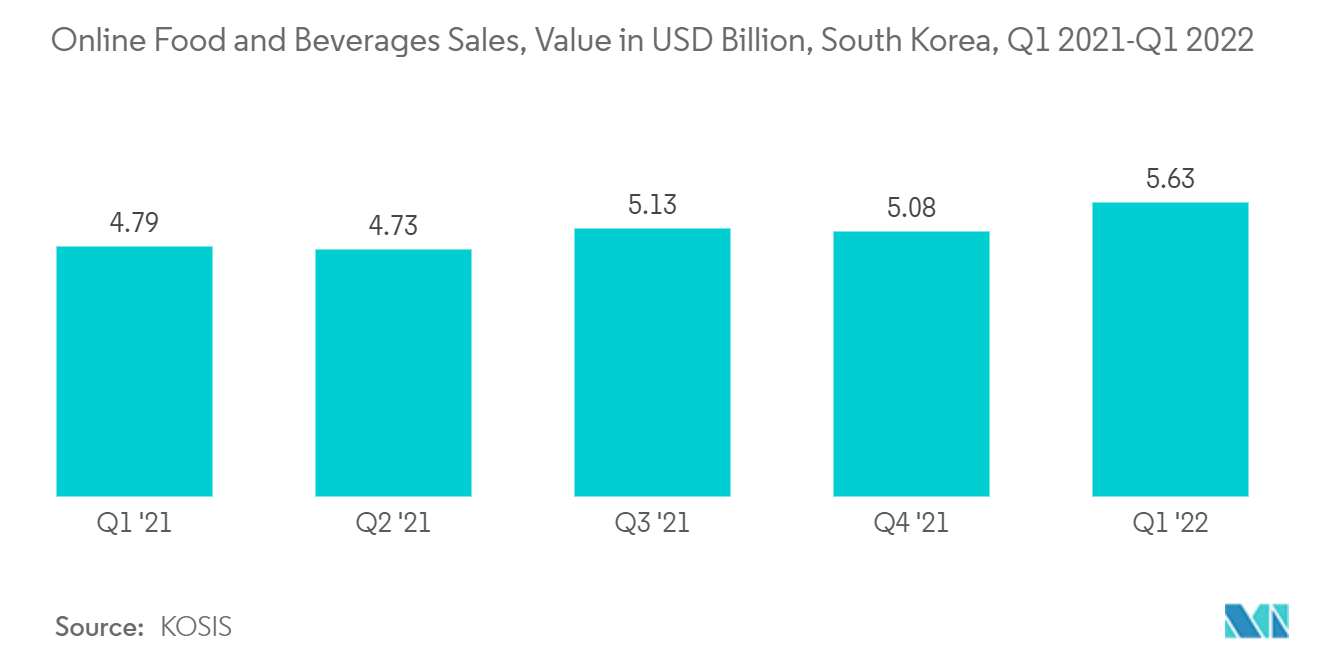
Growth In E-commerce Driving the CEP Market
South Korea has been drawing the attention of the global e-commerce industry in terms of growth rate and size compared to the overall consumer market since before the COVID-19 pandemic. Moreover, in Q1 2021, the mobile shopping transaction value in South Korea totaled more than KRW 31.3 trillion (USD 25.4 billion), with food services leading the categories at KRW 5.7 trillion (USD 4.63 billion). Mobile shopping is commonly used in South Korea, and the sector has shown continuous year-on-year growth within the online shopping sphere.
Meanwhile, in Q3 2021, online shopping transactions in South Korea grew by 19.6% compared to the same period in the previous year. In the future, the domestic e-commerce market may have different growth prospects for different product groups, but it is expected to continue to expand in the long term. This is because Korean consumers have already experienced the convenience of online purchases in various product groups, and online and offline distributors are also making continuous investments.
Furthermore, South Korean online retailers are fueling the new trend called live commerce, which combines streaming and e-commerce. However, the country's e-commerce market is expected to reach USD 325.12 billion in 2025. Factors such as increasing internet user penetration, the implementation of AI in retail, expanding urbanization, the escalating trend of online advertising, and increasing smartphone users are expected to drive market growth over the forecast period. Moreover, in 2021, online sales accounted for around 28% of retail sales, indicating further growth in online shopping.
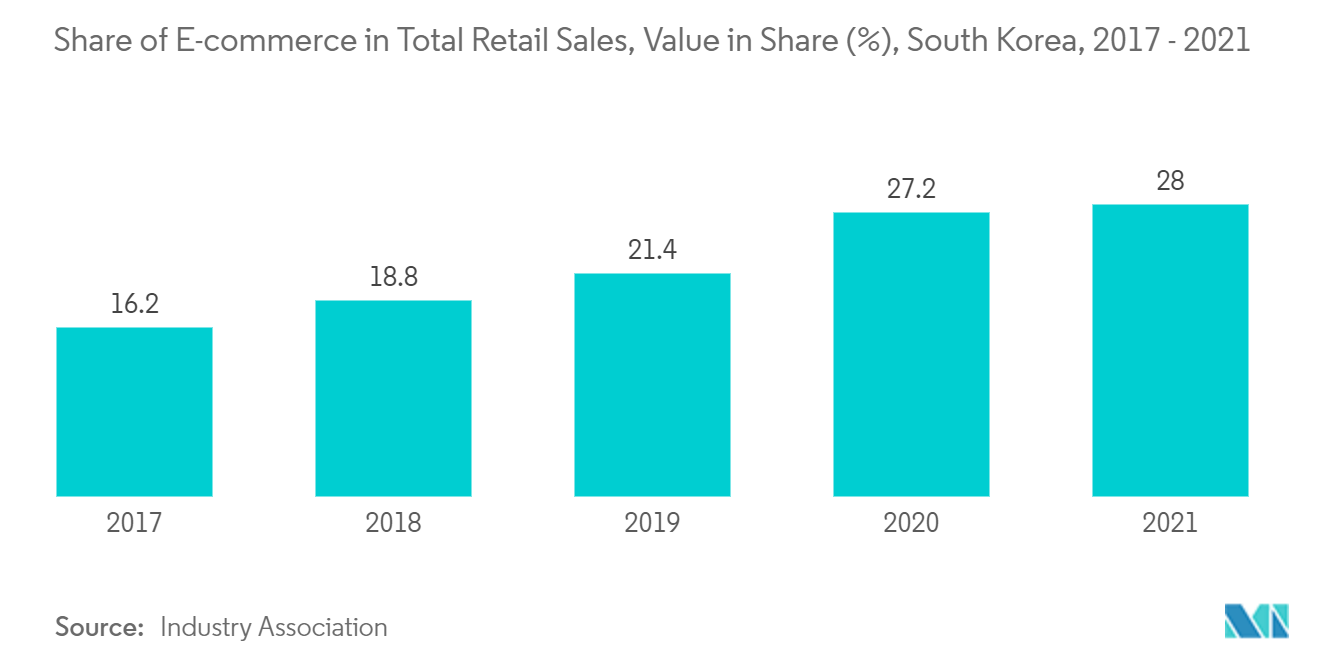
South Korean Domestic Courier, Express, and Parcel Industry Overview
The South Korean domestic CEP market is fragmented in nature, with a mix of global and local players, which makes the sector highly competitive. Some of the strong players in the country include CJ Logistics, Korea Post, Lotte Global Logistics, Hanjin Express, and Aramex. Unlike the global market, the current domestic online shopping market is not a monopolistic market centered on leading companies but rather involves intensifying competition among multiple companies. As high-cost competition in marketing and delivery continues, the market is expected to reorganize into a monopoly structure owing to mergers and acquisitions, and alliances between companies.
South Korean Domestic Courier, Express, and Parcel Market Leaders
-
CJ Logistics
-
Korea Post
-
Lotte Global Logistics
-
Hanjin Express
-
Aramex
*Disclaimer: Major Players sorted in no particular order
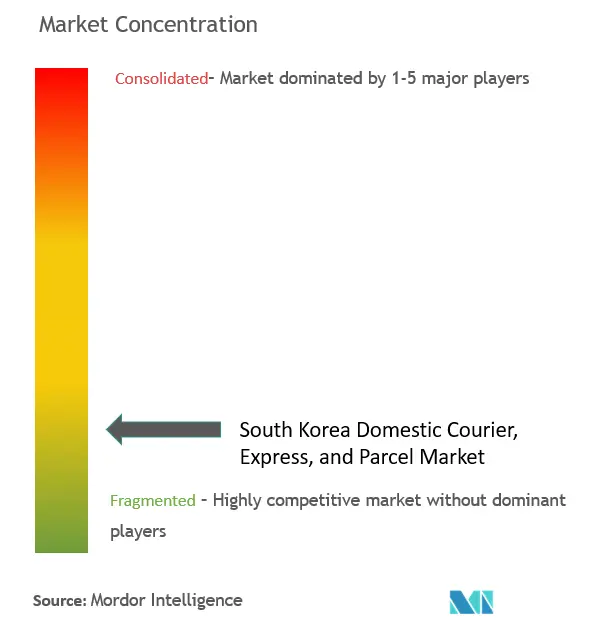
South Korean Domestic Courier, Express, and Parcel Market News
January 2023: Hanjin Co., Ltd (a logistics company), expanding its Daejeon Smart Mega Hub Terminal, which is scheduled to be completed in 2023. This terminal is spread across a gross floor area of 149,110 square meters, and the company has invested more than USD 230 million in this project. In addition, this logistic center will be equipped with state-of-the-art facilities, to achieve a goal of a 20% share in the parcel delivery market in South Korea.
November 2022: CJ Logistics (a logistics company headquartered in Seoul), partnered with Naver (South Korea's largest search engine), to launch the 'Guaranteed Delivery Date' service. This service will provide a 12 a.m. order closing service to sellers and buyers, ensuring all orders placed by midnight are dispatched the next day.
South Korean Domestic Courier, Express, and Parcel Market Report - Table of Contents
1. INTRODUCTION
1.1 Study Deliverables
1.2 Study Assumptions
1.3 Scope of the Study
2. RESEARCH METHODOLOGY
2.1 Analysis Methodology
2.2 Research Phases
3. EXECUTIVE SUMMARY
4. MARKET INSIGHTS
4.1 Current Market Scenario
4.2 Insights on Technological Trends
4.3 Insights on Government Regulations
4.4 Overview of the Logistics and Warehousing Market in South Korea
4.5 Brief on South Korea Freight Forwarding Market
4.6 Spotlight on South Korea E-commerce Sector (Commentary on Domestic E-commerce)
4.7 Impact of COVID-19 on the CEP Market (Short-term and Long-term Impact on the Market and Economy)
5. MARKET DYNAMICS
5.1 Market Drivers
5.2 Market Restraints/Challenges
5.3 Market Opportunities
5.4 Industry Attractiveness - Porter's Five Forces Analysis
5.4.1 Threat of New Entrants
5.4.2 Bargaining Power of Buyers/Consumers
5.4.3 Bargaining Power of Suppliers
5.4.4 Threat of Substitute Products
5.4.5 Intensity of Competitive Rivalry
6. MARKET SEGMENTATION
6.1 By Business Model
6.1.1 Business-to-Business (B2B)
6.1.2 Business-to-Customer (B2C)
6.1.3 Customer-to-Customer (C2C)
6.2 By Type
6.2.1 E-commerce
6.2.2 Non E-commerce
6.3 By End User
6.3.1 Services
6.3.2 Wholesale and Retail Trade
6.3.3 Healthcare
6.3.4 Industrial Manufacturing
6.3.5 Other End Users
7. COMPETITIVE LANDSCAPE
7.1 Overview (Market Concentration and Major Players)
7.2 Company Profiles
7.2.1 CJ Logistics
7.2.2 Korea Post
7.2.3 Lotte Global Logistics
7.2.4 Hanjin Express
7.2.5 Aramex
7.2.6 CH Robinson
7.2.7 DB Schenker
7.2.8 Linex Solutions
7.2.9 Nippon Express
7.2.10 Seko Logistics
7.2.11 SF International
7.2.12 FedEx*
- *List Not Exhaustive
8. FUTURE OF THE MARKET
9. APPENDIX
South Korean Domestic Courier, Express, and Parcel Industry Segmentation
Domestic Courier, express, and parcel (CEP) refers to the collection of services that involves the delivery of various goods and products through different mediums such as air, water, and land within the country. These packages delivered by CEP are mainly non-palletized and weigh around a hundred pounds collectively. Furthermore, the report offers a complete background analysis of the South Korea domestic courier, express, and parcel (CEP) market, including a market overview, market size estimation for critical segments, emerging trends by segment, and market dynamics.
The South Korean domestic courier, express, and parcel market is segmented by business model (business-to-business (B2B), business-to-customer (B2C), and customer-to-customer (C2C)), by type (e-commerce and non e-commerce), and by end user (service, wholesale and retail trade, healthcare, industrial manufacturing, and other end users). The report offers size and forecasts for the South Korean domestic courier, express, and parcel market in value (USD billion) for all the above segments. The impact of the COVID-19 pandemic is also covered in the report.
| By Business Model | |
| Business-to-Business (B2B) | |
| Business-to-Customer (B2C) | |
| Customer-to-Customer (C2C) |
| By Type | |
| E-commerce | |
| Non E-commerce |
| By End User | |
| Services | |
| Wholesale and Retail Trade | |
| Healthcare | |
| Industrial Manufacturing | |
| Other End Users |
South Korean Domestic Courier, Express, and Parcel Market Research FAQs
What is the current South Korea Domestic Courier, Express, and Parcel (CEP) Market size?
The South Korea Domestic Courier, Express, and Parcel (CEP) Market is projected to register a CAGR of greater than 10% during the forecast period (2024-2029)
Who are the key players in South Korea Domestic Courier, Express, and Parcel (CEP) Market?
CJ Logistics, Korea Post , Lotte Global Logistics, Hanjin Express and Aramex are the major companies operating in the South Korea Domestic Courier, Express, and Parcel (CEP) Market.
What years does this South Korea Domestic Courier, Express, and Parcel (CEP) Market cover?
The report covers the South Korea Domestic Courier, Express, and Parcel (CEP) Market historical market size for years: 2020, 2021, 2022 and 2023. The report also forecasts the South Korea Domestic Courier, Express, and Parcel (CEP) Market size for years: 2024, 2025, 2026, 2027, 2028 and 2029.
South Korea Domestic CEP Industry Report
Statistics for the 2024 South Korea Domestic CEP market share, size and revenue growth rate, created by Mordor Intelligence™ Industry Reports. South Korea Domestic CEP analysis includes a market forecast outlook 2029 and historical overview. Get a sample of this industry analysis as a free report PDF download.



